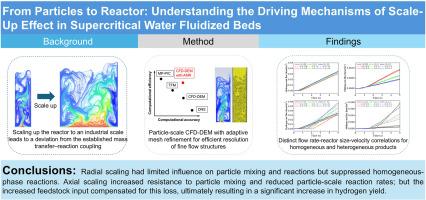Intrinsic mechanism of scale-up effects in supercritical water fluidized bed reactors from particle perspective
IF 4.3
2区 材料科学
Q2 ENGINEERING, CHEMICAL
引用次数: 0
Abstract
Supercritical water gasification is a promising method for efficient hydrogen production. Among various reactor designs, fluidized bed reactors demonstrate strong industrial potential due to their plugging resistance and favorable hydrodynamic properties. However, scaling up the reactor to industrial applications disrupts the mass transfer-reaction matching relationship established at the particle level, making it challenging to replicate the performance of smaller reactors. To mitigate the scale-up effect of the reactor, a fundamental understanding of particle-scale mechanisms is essential. In this study, high-resolution numerical simulations are employed to investigate particle dynamics across both reactor and particle scales. To enhance computational efficiency, adaptive mesh refinement and heterogeneous computing are utilized. The scale-up laws governing the internal flow structures and chemical reaction performance within the reactor are analyzed. The temperature, diffusion, and chemical reaction performance at the particle level are tracked, and statistical analyses are performed to elucidate the mechanisms driving the scale-up effects. Results reveal that the two scaling approaches affect reactor performance through different mechanisms. Radial scaling has minimal impact on particle mixing and reaction rates, whereas axial scaling reduces particle reaction rates; however, this reduction is compensated by an increased particle count, ultimately enhancing overall hydrogen yield. Additionally, higher superficial velocity enhances feedstock mixing and thermal uniformity, resulting in more uniform particle reactions, although it may hinder homogeneous reactions. These findings offer new insights into reactor scale-up effects and hold promise for guiding optimal and detailed design of future industrial-scale reactors.

超临界水流化床反应器放大效应的内在机理
超临界水气化是一种很有前途的高效制氢方法。在各种反应器设计中,流化床反应器因其抗堵塞性和良好的流体力学性能而显示出强大的工业潜力。然而,将反应器扩大到工业应用会破坏在颗粒水平上建立的传质反应匹配关系,从而使复制小型反应器的性能变得具有挑战性。为了减轻反应器的放大效应,对粒子尺度机制的基本理解是必不可少的。在本研究中,采用高分辨率数值模拟来研究反应器和粒子尺度上的粒子动力学。为了提高计算效率,采用了自适应网格细化和异构计算。分析了反应器内部流动结构和化学反应性能的放大规律。对颗粒水平的温度、扩散和化学反应性能进行了跟踪,并进行了统计分析,以阐明驱动放大效应的机制。结果表明,两种垢化方式对反应器性能的影响机制不同。径向结垢对颗粒混合和反应速率的影响最小,而轴向结垢会降低颗粒的反应速率;然而,这种减少被增加的粒子数所补偿,最终提高了总体的氢气产量。此外,较高的表面速度增强了原料混合和热均匀性,导致更均匀的颗粒反应,尽管它可能阻碍均相反应。这些发现为反应堆放大效应提供了新的见解,并有望指导未来工业规模反应堆的优化和详细设计。
本文章由计算机程序翻译,如有差异,请以英文原文为准。
求助全文
约1分钟内获得全文
求助全文
来源期刊

Particuology
工程技术-材料科学:综合
CiteScore
6.70
自引率
2.90%
发文量
1730
审稿时长
32 days
期刊介绍:
The word ‘particuology’ was coined to parallel the discipline for the science and technology of particles.
Particuology is an interdisciplinary journal that publishes frontier research articles and critical reviews on the discovery, formulation and engineering of particulate materials, processes and systems. It especially welcomes contributions utilising advanced theoretical, modelling and measurement methods to enable the discovery and creation of new particulate materials, and the manufacturing of functional particulate-based products, such as sensors.
Papers are handled by Thematic Editors who oversee contributions from specific subject fields. These fields are classified into: Particle Synthesis and Modification; Particle Characterization and Measurement; Granular Systems and Bulk Solids Technology; Fluidization and Particle-Fluid Systems; Aerosols; and Applications of Particle Technology.
Key topics concerning the creation and processing of particulates include:
-Modelling and simulation of particle formation, collective behaviour of particles and systems for particle production over a broad spectrum of length scales
-Mining of experimental data for particle synthesis and surface properties to facilitate the creation of new materials and processes
-Particle design and preparation including controlled response and sensing functionalities in formation, delivery systems and biological systems, etc.
-Experimental and computational methods for visualization and analysis of particulate system.
These topics are broadly relevant to the production of materials, pharmaceuticals and food, and to the conversion of energy resources to fuels and protection of the environment.
 求助内容:
求助内容: 应助结果提醒方式:
应助结果提醒方式:


